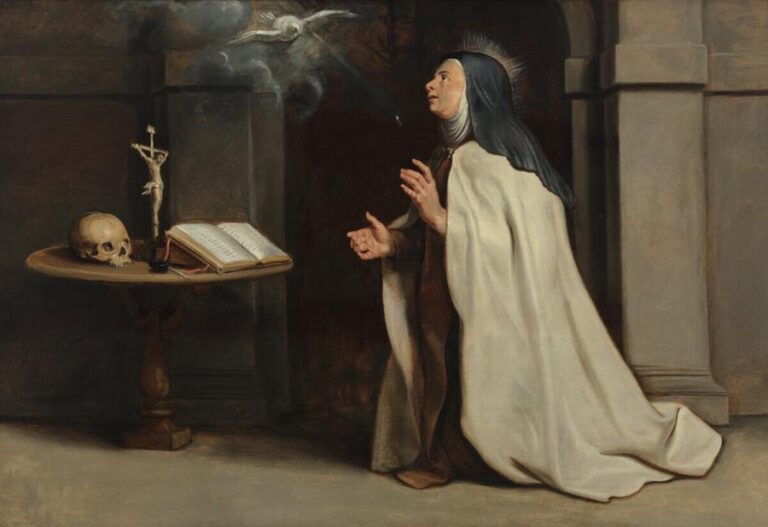1 July 2024
Saint Teresa of Avila, Part 4 | The Year of Prayer
By Joey Belleza, PhD (Cantab.)
This instalment will sum up our mini-series on Saint Teresa of Avila. Thus far, we have examined the first three stages of prayer, which she compares, sequentially, to drawing water from a well, to drawing water from a mill or windlass, and to drawing water from a stream or river. Each stage represents an increasing facility in watering the garden of one’s prayer life. Finally, in the fourth stage of prayer, the garden is watered by rain that pours down from the heavenly Father himself. Here, the labour of the first three stages gives way to the pure gratuity of God’s grace, such that the Christian might even be flooded by the love of God to the point of a rapture. This is where “the faculties of the soul” remain “in a state of suspension,” and “all outward strength vanishes, while the strength of the soul increases so that it may better have the fruition of this bliss” (The Life of Saint Teresa, ch. 18). This temporary abstraction from sensible or intellectual experience, as Teresa describes it, seems similar to Saint Paul’s own ascent to “the third heaven” as recounted in 2 Corinthians 12.
However, we should remember that such an experience of rapture is a special gift of God, and that the Christian who does not receive this gift is no less capable of union with God. In fact, Teresa distinguishes between the “elevation” or “rapture” of the soul, on one hand, and the union with God which one may experience in the fourth stage of prayer. Rapture is often a sign of a special union, but union with God is also manifested when the soul actively knows and loves God. Indeed, the benefits enjoyed after rapture continue to manifest the soul’s union with God. Such a soul, “without knowing it, and doing nothing consciously to that end, begins to benefit its neighbours, and they become aware of this benefit because the flowers now have so powerful a fragrance as to make the neighbours desire to approach them” (The Life of Saint Teresa, ch. 19). The garden of the soul flourishes without the fatigue of the first two stages, and this flourishing comes from the rain which God himself sends down. Let us see discover further what the saint means when distinguishing rapture from union.
In these raptures the soul seems no longer to animate the body, and thus the natural heat of the body is felt to be very sensibly diminished: it gradually becomes colder, though conscious of the greatest sweetness and delight. No means of resistance is possible, whereas in union, where we are on our own ground, such a means exists: resistance may be painful and violent, but it can always almost be effected. But with rapture, as a rule, there is no such possibility. Often it comes like a strong, swift impulse, before your thought can forewarn you of it or before you can do anything to help yourself. You see and feel this cloud, or this powerful eagle, rising and bearing up up with it on its wings.Notice how Teresa distinguishes union as occurring “when we are on our own ground.” This passage also suggests that, while rapture consists of a certain disjunction of body and soul, union occurs when the body and soul are once again in active harmony, when we are possessed of our normal faculties, and thus when we are fully free to even “resist” union. Thus, rapture is never the end or purpose of mystical experience, but is only a further means toward the union wherein the entire human creature, in body and soul, participates actively in the life of virtue. As we close our reflections on Saint Teresa, let us not be discouraged if we never experience the extraordinary transverberations, ecstasies, and levitations granted to exceptional saints like her. Even for such famous mystics, such experiences were never everyday occurrences but gifts given by God at times and places of his choosing. Rather, let us enter the fourth stage of prayer by being mindful of all the graces which God already pours down abundantly on us, and to unite ourselves to him not only in moments of solitary prayer and contemplation, but also in every act of perfect charity toward our neighbours. Thus the fragrance of God’s grace will continue to attract more souls to the garden of heavenly delights. In the next three instalments, we will shift our focus to another high medieval Doctor of the Church and contemporary of Saint Thomas Aquinas: the Franciscan theologian Saint Bonaventure of Bagnoregio.

